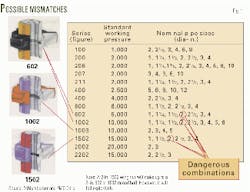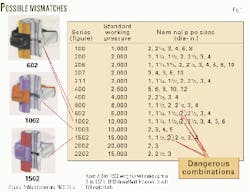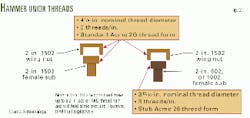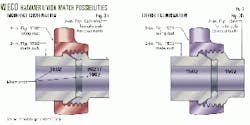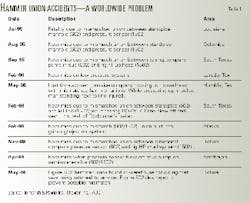Hammer union mismatches threaten wellsite personnel
Fatalities, injuries, near misses, and uncontrolled releases of potentially hazardous fluid may result when two of the most widely used high-pressure hammer unions are accidentally mated.
The tools in question are the 2-in. Figure 602 (6,000-psi rating), and the 2-in. Figure 1502 (15,000 psi; Figs. 1-3).
Additionally, two other less commonly used hammer unions, the 2-in. Figure 1002 (10,000 psi) and Guiberson thread halves, can be cross-matched as well.
Mismatched hammer unions that have been pressurized can lead to an:
- 8 lb wing-nut projectile that can be propelled in any direction.
- Uncontrolled release of high-pressure fluid that may strike an oil field worker.
- Uncontrolled release of toxic fluids (oil or synthetic-base drilling mud) that may pollute the environment.
Over the past 15 years, at least one death, seven near misses, and one lost time accident have been documented from these mismatched, pressurized unions, along with a number of unreported accidents (Table 1).
At least two such events occurred this year and indicate a serious industry problem in need of immediate attention.
Concerned individual
After an employee was killed in 1995, Warren Hubler, HSE manager for Helmerich & Payne Inc. (H&P), spearheaded a move to solve the 2-in. high-pressure hammer union safety issue. In the 1995 case, a simple mud-logging pressure sensor on the standpipe malfunctioned.
"To keep drilling, the pressure sensor with a 2-in. Figure 602 wing nut was removed and a replacement was hastily retrieved from the spare-parts box in the doghouse," he said.
But because the thread end on the standpipe was part of a 602 union (Fig. 4) and the replacement part included a 1502 wing nut (Fig. 4), the floorhand died as the pumps were kicked in and pressured up.
"The bull plug and wing nut took out his feet and the jet of the mud blew him into the A-leg headfirst," Hubler said. "He never knew what hit him and he never regained consciousness."
Additionally, only 2,000 psi were placed on the union at the time it blew, showing that mismatched unions rated at 6,000 and 15,000 psi, respectively, will not even hold the pressure rating of the lesser end member.
Following this accident, H&P removed all 2-in. Figure 602s from its rig fleet and standardized on the 2-in. Figure 1502. Next, the company provided check rings, known as "Go/No-Go" gauges, to all rig supervisors (Fig. 5). These gauges will not pass over the over the thread half of the 1502 but will pass over the thread half of the 602.
Finally, H&P now inspects all third-party service companies on the rig location to ensure exclusive use of 1502 hammer unions for their 2-in. applications (see Box). Unfortunately, this is only one company's solution.
Short-term solutions
Through a series of meetings beginning March 1999, drillers, manufacturers, suppliers, service personnel, and operators began taking action to mitigate the problem until a permanent solution is found.
Some of the short-term solutions include:
- Standardization on the 2-in. Figure 1502. Removal and destruction of 2-in. 602s, 1002s, and Guiberson unions.
- Continuance of the manufacturers' original color-coding system.
- Installation of safety cables across hammer-union halves of piping or to the pressure source.
- Coordinated efforts and communication among the operator, drilling contractor, and service company to ensure equipment compatibility.
- Regular safety meetings conducted prior to cement jobs, well tests, rig ups, and other activities.
- Inspection of standpipes and choke manifolds for mismatch opportunities.
- Installation of steel identification plates or inscription on both hammer-union ends with pressure rating and type clearly marked.
- Continued employee education and training.
- Hammer-union audits.
- Rig surveys that focus on "the potential line of fire." Reorient hammer unions from horizontal to vertical position, allowing personnel time to react in case there is a breach.
- Inspection of third-party equipment before rig up.
- Utilization of the "Go/No-Go" gauge to ensure a 1502 thread half (female sub) is being used.
- Development of API specifications and standards, currently nonexistent.
Some of these recommendations have already been put into place.
Schlumberger (Dowell), for example, color codes all of its connections and stencils every hammer union with the pressure rating. Additionally, the company has implemented an audit system with tracking codes, allowing personnel to track down and evaluate problem areas.
Short-term problems
Yet even some of these short-term solutions have problems.
Smaller rigs and well-testing companies, for example, may balk at using the 1502 when the 602 is the most applicable and economical hammer union for lower-pressure work. Additionally, some drilling contractors may hesitate to maintain the original manufacturer's color as it can clash with the "official company color."
Then there is the problem of bringing stacked rigs back to work, typically conducted quickly to keep up with the cyclical drilling market. In this case, as companies hire new employees, training takes time with "green hands," and more seasoned employees may feel rushed to get the rig up and drilling again, neglecting to conduct thorough audits.
But more worrisome is the false sense of security that can evolve from the standardization on high-pressure, 15,000-psi unions. "Drilling contractors should be careful," said Don Douglas, flowline project manager with FMC Corp. "They are only making a connection point in the system, not establishing the pressure rating of the system."
In other words, the piping may be capable of only holding 5,000 psi because of the type of pipe used or other components in the system, significantly less then the pressure rating of the 1502.
Long-term solution?
Jim Yancy, executive director of AESC (Assocation of Energy Service Cos.), feels the ultimate answer can only come through the manufacturing process, with inherent design attributes built in so they cannot be physically mismatched.
"You can train all you want," he told OGJ, "but if there's always the possibility of making up these [mismatches], especially if there are forgotten [stashes] or third-party companies on location, then you won't solve the problem."
However, several roadblocks have made this alternative impractical.
- First of all, the pervasive presence of 2-in. hammer unions across the drilling, well-testing, cementing, and production sectors, precludes a rapid and complete replacement of existing inventory.
"You have a huge installed base of hammer unions," said Steve Barrett, marketing manager with FMC, "and the industry is not committed to a wholesale change in inventory."
For example, a retrofit of perhaps 20 retooled 2-in. hammer union sets for every US land rig would require perhaps 20,000 new matches in all, not including those rigs that are stacked and certainly not including those found on cement truck fleets, workover units, offshore rigs, platforms, and so on.
This would obviously be a costly and logistically difficult solution for the drilling contractor and service companies to accomplish.
- Secondly, "Hammer-union production is extremely fragmented with about 20 manufacturers and thousands of machine shops making various components for the fittings," Barrett said. Essentially, trying to reach and implement wide-scale agreement on tooling standards would be nearly impossible.
- Thirdly, even if 2-in. hammer union specification were put into place, as new hammer union sets enter the work place, this would only add to further confusion with the already existent 602s, 1002s, and 1502s.
- Finally, "One reason the solution of the thread re-design has been so difficult is that every design solution presented to date to solve the mismatched problem with Figure 1502s and Figure 602s has created a potential mismatch with some other pressure rating," said Rich Duran, operations manager-onshore for Shell E&P Co.
"At the first industry-wide meeting, we decided that we would not accept a design change that solved our problem if it created a hazard for someone else."
Where's the solution?
Realizing that a manufacturing fix is currently impossible, many companies including Schlumberger (Dowell), Global Marine Inc., Rowan Companies Inc., Grey Wolf Inc., Nabors Industies Inc., and Noble Drilling Co. have followed the path of H&P, opting to standardize on the 1502 hammer union for drilling operations while compelling partners to do likewise.
Furthermore, some operators including Shell E&P Co. and Chevron Inc. are requiring all parties to use the 1502 in their contract equipment specifications, except in isolated cases where it is impractical to do so.
Nevertheless, these are only "band-aid" fixes, and until the industry as a whole does a better job of standardization, identification, and training, we may undergo more tragedies.
This is plainly shown by another safety alert posted by the International Association of Drilling Contractors last May (www. iadc.org - Safety Alerts).
"Although two alerts have been issued on this equipment already, incidents are still occurring in the drilling industryellipse.
"One incident occurred when a 1502 wing nut male sub union holding a pressure sensor was attached to a 602 female union on the mud pump. The 1502 union and pressure sensor blew off the discharge of a mud pump."
Continuing, IADC said, "Another incident occurred when one service company's 1502 wing nut for the male sub was made up to another service company's 602 female half. While attempting to test the surface casing, the rams were closed and the standpipe pressure was slowly brought up.
"The intended test pressure was to be 1,500 psi. When the pressure reached 1,300 psi, the 1502 union stripped out and blew off and struck a third-party service employee causing serious injury."
Standardization on the 2-in Figure 1502: committee minutes*
Pros:
- The well testing companies said it was not cost prohibitive to switch over from 602s to 1502s.
- Doable for the producers.
- Reduce likelihood of possible mismatched opportunity.
- Simplify operations - easier to train.
- Less inventory.
- Easy for new installation.
- Readily available. Already in maunfacturer's production.
- Procurement - part of solution - quality control easier.
- Fewer crossovers.
Cons:
- 1502 union, rated at 15,000 psi, and line threads limited to 10,000 psi working pressure. Personnel may feel they have a 15,000-psi line when it is probably several thousand pounds less.
- Don't want high-pressure fittings on low-pressure piping
- Not doable for small contractors and service companies. Too costly.
- Must be enforced.
- Higher cost.
- Counterfeit unions will be manufactured by someone.
- Industry would assume it's done and then mismatched union would still show up on a rig.
- Difficulty to target worldwide.
*Edited; Hammer Union Committee, Mar. 18, 1999.
